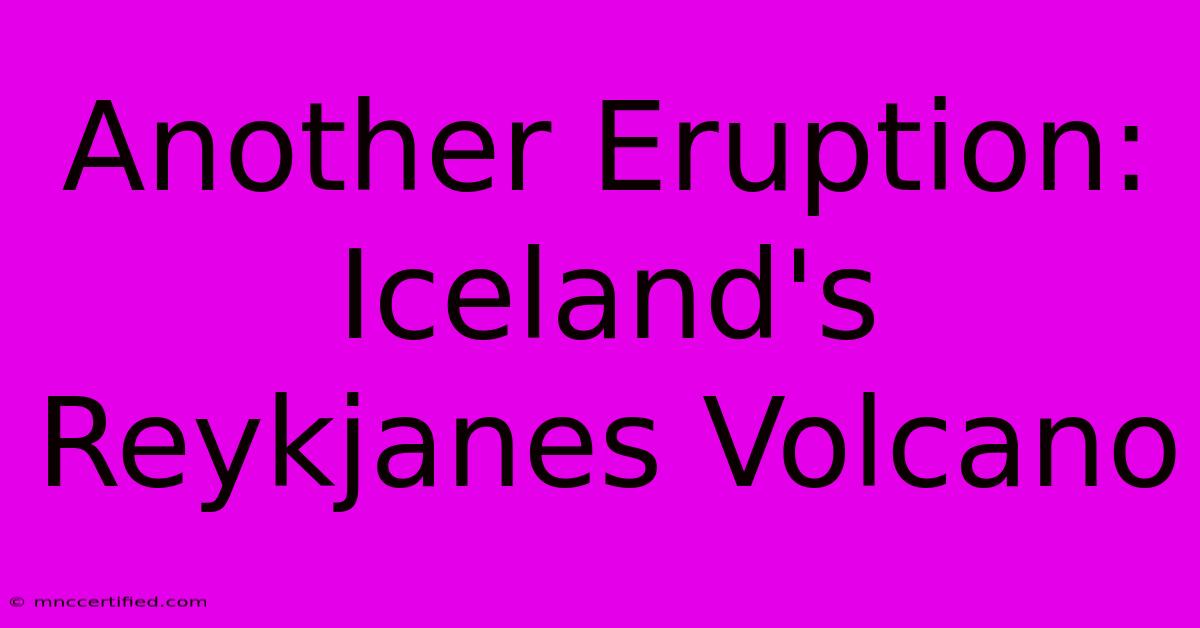Another Eruption: Iceland's Reykjanes Volcano

Table of Contents
Another Eruption: Iceland's Reykjanes Volcano – A Closer Look
Iceland, the land of fire and ice, has once again captivated the world with a volcanic eruption. This time, the action is centered on the Reykjanes Peninsula, a region known for its geothermal activity and stunning landscapes. This article delves into the recent eruption, exploring its impact, geological significance, and the captivating spectacle it presents.
The Reykjanes Peninsula: A Hotspot of Volcanic Activity
The Reykjanes Peninsula, located southwest of Iceland's capital Reykjavik, sits atop the Mid-Atlantic Ridge, a divergent tectonic plate boundary. This geological setting makes it a highly active volcanic region, prone to both effusive (lava flows) and explosive eruptions. The current eruption, while dramatic, is largely effusive, meaning it's characterized by lava flows rather than large-scale explosive activity. This is relatively less dangerous, though still incredibly powerful and necessitates careful monitoring and safety precautions.
Geological Significance of the Eruption
This eruption is particularly significant for several reasons. Firstly, it's part of a recent increase in volcanic activity in the Reykjanes region, marking a period of heightened geological dynamism. Scientists are closely studying this activity to better understand the processes driving these eruptions and predict future events. Secondly, the composition of the lava and the style of eruption provide valuable data for refining volcanic models and improving our understanding of volcanic processes more broadly. This research has global implications, helping us better prepare for and mitigate volcanic hazards worldwide.
The Eruption's Impact: Local and Global
While the eruption itself poses minimal immediate threat to populated areas, its impact is multifaceted:
Local Impact:
- Air Quality: Volcanic gases, including sulfur dioxide, can impact air quality in nearby areas. Authorities are closely monitoring air quality and issuing advisories as needed. Knowing when and where to check for these updates is crucial for residents and visitors alike.
- Tourism: Ironically, volcanic eruptions can be a major tourist draw. While safety is paramount, responsible tourism around the eruption site can boost the local economy. Sustainable tourism practices are essential to minimize environmental impact.
- Infrastructure: Lava flows can disrupt infrastructure, including roads and utilities. Authorities are constantly assessing potential risks and implementing mitigation strategies.
Global Impact:
- Climate Change: While the impact of a single eruption on global climate is typically limited, large-scale volcanic activity can influence atmospheric composition and potentially affect weather patterns. Scientists continue to monitor the eruption's contribution to atmospheric changes.
- Scientific Research: The eruption provides a unique opportunity for scientists worldwide to gather invaluable data, advancing our understanding of volcanology and geological processes.
Safety and Viewing the Eruption
Safety should always be the top priority. It's crucial to follow guidelines issued by local authorities and only view the eruption from designated safe zones. Never approach the active lava flows or enter restricted areas. Heeding official warnings is essential to avoid potential dangers.
The Future of Reykjanes Volcano
The duration and intensity of the eruption remain uncertain. Scientists will continue to monitor the volcano closely, using a variety of techniques to track its activity and predict future behavior. This ongoing monitoring is essential for public safety and helps to inform future management strategies.
Conclusion: A Spectacle of Nature's Power
The Reykjanes eruption is a powerful reminder of the dynamic forces shaping our planet. It's a spectacle of nature's raw power, prompting both awe and caution. By understanding the geological context, potential impacts, and necessary safety precautions, we can appreciate this extraordinary event while ensuring the safety and well-being of both local communities and visitors. Continued research and monitoring will undoubtedly enhance our understanding of this magnificent and potentially dangerous natural phenomenon.

Thank you for visiting our website wich cover about Another Eruption: Iceland's Reykjanes Volcano. We hope the information provided has been useful to you. Feel free to contact us if you have any questions or need further assistance. See you next time and dont miss to bookmark.
Featured Posts
-
Gaetz Withdraws Ag Bid Following Sexual Assault Claims
Nov 22, 2024
-
Michigan Beef Recall 167 000 Lbs Contaminated
Nov 22, 2024
-
Laos Poisoning Briton Simone White Dead
Nov 22, 2024
-
Captain Tom Gin Charity Commission Report
Nov 22, 2024
-
Monday Night Football Channel Browns Game
Nov 22, 2024